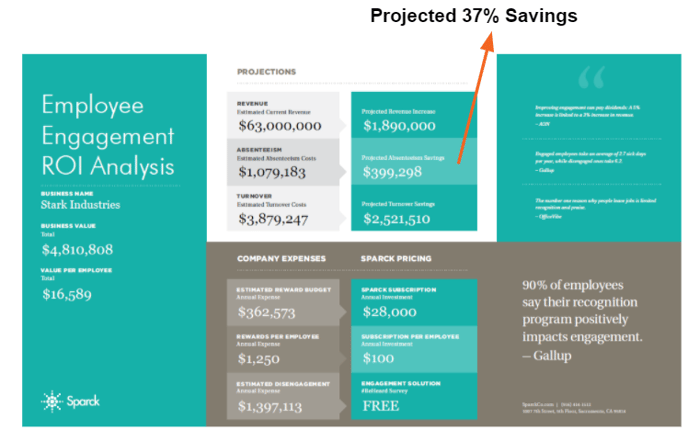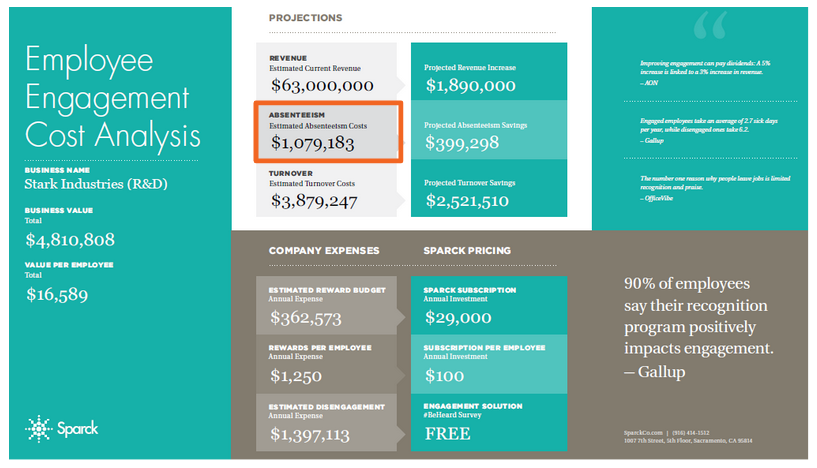Here's a high level overview of how to calculate absenteeism costs and projected savings.
The second section to cover in the executive meeting is absenteeism. The most important thing to highlight in this section is that an increase in engagement can reduce the number of “sick days” which increases productivity and saves them money. She wanted to know how?
Well, engaged employees take an average of 2.7 sick days per year while disengaged employees double that with an average of 6.2 sick days. This is important because when someone takes a “sick day," you are paying for their time off while losing their productivity. Lost time and money is never desirable!
Luckily, increased engagement saves about 37% in absenteeism costs by converting those disengaged employees into more committed and engaged individuals who won’t take as many “sick days.” This shift creates an opportunity to save money and increase productivity by keeping your employees excited about their work and invested in the organization.

For the example above, the total absenteeism costs calculated by the Sparck Engagement Calculator was $1,079,183. In other words, if Stark Industries increased engagement, they can save an average of 37% in absenteeism costs, which is just shy of $400,000. These savings are realized because increased engagement will reduce the number of sick days by converting disengaged employees into more enthusiastic and committed team members. This transition will increase productivity and save the department money.
The Formulas
Though this is a multiple step process, at a high level, we are able to calculate the total absenteeism costs of $1,079,183 and the projected savings of $399,298 using these formulas:
- Estimated Absenteeism Costs: Total Absenteeism Costs for Engaged Employees + Total Absenteeism Costs for Disengaged Employees
- Projected Absenteeism Savings: Total Absenteeism Costs x 37%
Estimated Absenteeism Costs
Starting with Estimated Absenteeism Costs, the number of average “sick days” taken by engaged employees compared to disengaged employees is the most important area to take into account. We use researched backed numbers of 2.7 average sick days for engaged employees and 6.2 average sick days for disengaged employees.
Once we identify the costs for each, we add them together to get the total projected absenteeism costs for on an annual basis.

The Estimated Absenteeism Costs of $1,079,183 is broken down this way:
- $723,525 (engaged employees)
- $355,660 (disengaged employees)
To understand how we got $723,525 in total absenteeism costs for engaged employees and $355,660 for disengaged employees, here’s what it comes down to...
First, when an employee takes a sick day, a company loses productivity and money because they are still paying for that time even though no work is being done. In order to measure these two areas to get the total absenteeism costs, we have to see how much productivity and money is lost for each type of employee.
- Lost Productivity: We are able to calculate how much productivity the division is losing by looking at the average Revenue per Employee. This measures the average financial output of each employee. We need this number to uncover how much productivity is lost when an employee takes a sick day.
- Lost Money: We then need to get an estimate of how much money is lost by looking at the Average Salary. These are dollars that are being spent for hours that aren’t being worked. After all, their employees have sick time so they are still being compensated even though they aren’t in the office.
Secondly, we need to calculate absenteeism costs for engaged employees separately from disengaged employees because because absenteeism costs vary drastically due to the amount of sick days they take. Engaged employees take an average of 2.7 days and disengaged employees take 6.2 days a year.
Here's the formula for Absenteeism Costs:
| Lost Productivity | Lost Money | |
| (Avg. Revenue Per Employee x Avg. Sick Days) | + (Avg. Salary x Avg. Sick Days) | = Absenteeism Cost |
This calculation figures out the cost for a single engaged employee and a single disengaged employee, so you also have to know many employees in the division are engaged and disengaged to determine the total absenteeism costs for each group.
If you've never done an engagement survey before, you may not know how many of your employees were engaged or disengaged. According to Gallup, 17% of the workforce is disengaged, so it serves as a credible benchmark and this number is set as a default in the Sparck Calculator. 17% of 290 employees is 49, which means we have have 49 disengaged employees and 241 engaged employees.
Gallup found a historic drop in engagement levels as of June 2020, but for data purposes, we still recommend using the benchmark of 17% disengaged employees. We're in a very unique time right now.
High Level Overview of Absenteeism Costs and Savings
Because absenteeism calculations are far more complex than our revenue calculation, we broke it down into three different parts:
Engaged Employees: To determine the absenteeism costs for engaged employees, we multiply 241 (83% of 290) employees by the individual absenteeism cost for an engaged employee to get the total engaged employee absenteeism costs of $723,525.
Disengaged Employees: To determine the absenteeism costs for disengaged employees, we can multiply the individual absenteeism cost for a disengaged employee by 49 (17% of 290) employees to get the total cost of $355,660.
Total Absenteeism Costs + Projected Savings: We add the two total costs together ($355,660 and $723,525), which gets us to the total absenteeism costs of $1,079,183 on the ROI Analysis. Then, to uncover the potential savings, we simply multiply this total cost by 37%.
Next Steps:
- Now the absenteeism calculations are far more complex than our revenue calculation, so to understand where we got the numbers above, we also walk you through the step-by-step calculations of absenteeism costs and projected savings.
- Go back to the ROI Analysis Toolkit to learn more about the different sections of the ROI Analysis.